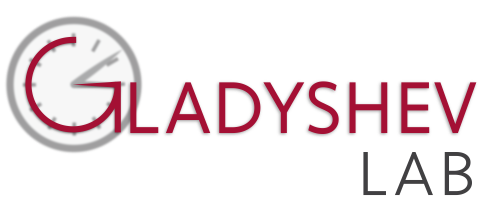2021 Articles
Gladyshev VN, Kritchevsky SB, Clarke SG, Cuervo AM, Fiehn O, de Magalhães JP, Mau T, Maes M, Moritz RL, Niedernhofer LJ, Schaftingen EV, Tranah GJ, Walsh K, Yura Y, Zhang B, Cummings SR (2021) Molecular damage in aging. Nature Aging, 1, 1096–1106
Trapp A, Kerepesi C & Gladyshev VN (2021) Profiling epigenetic age in single cells. Nature Aging, 1, 1189–1201
Zhang B, Lee DE, Trapp A, Tyshkovskiy A, Lu AT, Bareja A, Kerepesi C, Katz LH, Shindyapina AV, Dmitriev SE, Baht GS, Horvath S, Gladyshev VN (2021) Multi-omic rejuvenation and lifespan extension upon exposure to youthful circulation. bioRxiv, 10.1101/2021.11.11.468258
Trapp A & Gladyshev VN (2021) Cost-effective epigenetic age profiling in shallow methylation sequencing data. bioRxiv, 10.1101/2021.10.25.465778
Griffin PT, Kane AE, Trapp A, Li J, McNamara MS, Meer MV, MacArthur MR, Mitchell SJ, Mueller AL, Colleen C, Vera DL, Kerepesi C, Hooten NN, Mitchell JR, Evans MK, Gladyshev VN, Sinclair DA (2021) Ultra-cheap and scalable epigenetic age predictions with TIME-Seq. bioRxiv, 10.1101/2021.10.25.465725
Kerepesi C, Zhang B, Lee SL, Trapp A & Gladyshev VN (2021) Epigenetic clocks reveal a rejuvenation event during embryogenesis followed by aging. Science Advances 7, eabg6082.
Shindyapina AV, Castro JP, Barbieri A, Strelkova OS, Paulo JA, Kerepesi C, Petrashen AP, Mariotti M, Meer M, Hu Y, Losyev G, Indzhykulian AA, Gygi SP, Sedivy JM, Manis JP & Gladyshev VN (2021) Aging predisposes B cells to malignancy by activating c-Myc and perturbing the genome and epigenome. bioRxiv, 10.1101/2021.02.23.432500.
Ying K, Zhai R, Pyrkov TV, Shindyapina AV, Mariotti M, Fedichev PO, Shen X &; Gladyshev VN (2021) Genetic and phenotypic analysis of the causal relationship between aging and COVID-19. Communications Medicine 5, e2144.
Jin L, Tang Q, Hu S, Chen Z, Zhou X, Zeng B, Wang Y, He M, Li Y, Gui L, Shen L, Long K, Ma J, Wang X, Chen Z, Jiang Y, Tang G, Zhu L, Liu F, Zhang B, Huang Z, Li G, Li D, Gladyshev VN, Yin J, Gu Y, Li X & Li M (2021) A pig BodyMap transcriptome reveals diverse tissue physiologies and evolutionary dynamics of transcription. Nature Communications 12, 3715.
Zhang L, Dong X, Tian X, Lee M, Ablaeva J, Firsanov D, Lee SG, Maslov AY, Gladyshev VN, Seluanov A, Gorbunova V & Vijg J (2021) Maintenance of genome sequence integrity in long- and short-lived rodent species. Science Advances 7, eabj3284.
Emmrich S, Tolibzoda Zakusilo F, Trapp A, Zhou X, Zhang Q, Irving EM, Drage MG, Zhang Z, Gladyshev VN, Seluanov A & Gorbunova V (2021) Ectopic cervical thymi and no thymic involution until midlife in naked mole rats. Aging Cell 20, e13477.
Gladyshev VN (2021) The Ground Zero of Organismal Life and Aging. Trends in Molecular Medicine, 27, 11-19
Ristow M, Lee CH, De Bock K, Gladyshev VN, Hotamisligil GS & Manning BD (2021) James R. Mitchell (1971-2020). Cell Metabolism 33, 458-461
Augereau A, Mariotti M, Pousse M, Filipponi D, Libert F, Beck B, Gorbunova V, Gilson E & Gladyshev VN (2021) Naked mole rat TRF1 safeguards glycolytic capacity and telomere replication under low oxygen. Science Advances , 7, eabe0174
Kaya A, Phua CZJ, Lee M, Wang L, Tyshkovskiy A, Ma S, Barre B, Liu W, Harrison BR, Zhao X, Zhou X, Wasko BM, Bammler TK, Promislow DE, Kaeberlein M & Gladyshev VN (2021) Evolution of natural lifespan variation and molecular strategies of extended lifespan. eLife, 10:e64860.
Tian R, Han K, Geng Y, Yang C, Guo H, Shi C, Xu S, Yang G, Zhou X, Gladyshev VN, Liu X, Chopin LK, Fisher DO, Baker AM, Leiner NO, Fan G & Seim I (2021) A Chromosome-Level Genome of the Agile Gracile Mouse Opossum (Gracilinanus agilis). Molecular Biology and Evolution 13, evab162.
Khera N, Santesmasses D, Kerepesi C & Gladyshev VN (2021) COVID-19 mortality rate in children is U-shaped. Aging 13, 19954-19962.
Tian R, Han K, Geng Y, Yang C, Shi C, Thomas PB, Pearce C, Moffatt K, Ma S, Xu S, Yang G, Zhou X, Gladyshev VN, Liu X, Fisher DO, Chopin LK, Leiner NO, Baker AM, Fan G & Seim I (2021) A chromosome-level genome of Antechinus flavipes provides a reference for an Australian marsupial genus with male death after mating. Molecular Ecology Resources, 22 740-754.
Moldakozhayev A, Tskhay A & Gladyshev VN (2021) Applying deductive reasoning and the principles of particle physics to aging research. Aging, 13 22611-22622.
Egorov AA, Alexandrov AI, Urakov VN, Makeeva DS, Edakin RO, Kushchenko AS, Gladyshev VN, Kulakovskiy IV & Dmitriev SE. (2021) A standard knockout procedure alters expression of adjacent loci at the translational level. International Journal of Molecular Sciences49 11134.
Canter JA, Ernst SE, Peters KM, Carlson BA, Thielman NRJ, Grysczyk L, Udofe P, Yu Y, Cao L, Davis CD, Gladyshev VN, Hatfield DL & Tsuji PA (2021) Selenium and the 15kDa Selenoprotein Impact Colorectal Tumorigenesis by Modulating Intestinal Barrier Integrity. International Journal of Molecular Sciences, 22 10651.
Omotoso O, Gladyshev VN & Zhou X (2021) Lifespan Extension in Long-Lived Vertebrates Rooted in Ecological Adaptation. Frontiers in Cell and Developmental Biology, 9 704966.
Zhang Q, Tombline G, Ablaeva J, Zhang L, Zhou X, Smith Z, Zhao Y, Xiaoli AM, Wang Z, Lin JR, Jabalameli MR, Mitra J, Nguyen N, Vijg J, Seluanov A, Gladyshev VN, Gorbunova V & Zhang ZD (2021) Genomic expansion of Aldh1a1 protects beavers against high metabolic aldehydes from lipid oxidation. Cell Reports, 37 109965.
Santesmasses D & Gladyshev VN (2021) Pathogenic Variants in Selenoproteins and Selenocysteine Biosynthesis Machinery. International Journal of Molecular Sciences, 22 11593.
Bang J, Han M, Yoo TJ, Qiao L, Jung J, Na J, Carlson BA, Gladyshev VN, Hatfield DL, Kim JH, Kim LK & Lee BJ. (2021) Identification of Signaling Pathways for Early Embryonic Lethality and Developmental Retardation in Sephs1-/- Mice. International Journal of Molecular Sciences, 22 11647.
Gerashchenko MV, Peterfi Z, Yim SH & Gladyshev VN (2021) Translation elongation rate varies among organs and decreases with age. Nucleic Acids Research, 49 e9
Vorontsov IE, Egorov AA, Anisimova AS, Eliseeva IA, Makeev VJ, Gladyshev VN, Dmitriev SE & Kulakovskiy IV (2021) Assessing Ribosome Distribution Along Transcripts with Polarity Scores and Regression Slope Estimates. Methods in Molecular Medicine, 2252:269-294. doi: 10.1007/978-1-0716-1150-0_13
Mammalian Methylation Consortium (2021) Universal DNA methylation age across mammalian tissues. bioRxiv, 10.1101/2021.01.18.426733
Haghani A, Lu AT, Li CZ, Robeck TR, Belov K, Breeze CE, Brooke RT, Clarke S, Faulkes CG, Fei Z, Ferguson SH, Finno CJ, Gladyshev VN, Gorbunova V, Goya RG, Hogan AN, Hogg CJ, Hore TA, Kiaris H, Kordowitzki P, Banks G, Koski WR, Mozhui K, Naderi A, Ostrander EA, Parsons KM, Plassais J, Robbins J, Sears KE, Seluanov A, Steinman KJ, Szladovits B, Thompson MJ, Villar D, Wang N, Wilkinson GS, Young BG, Zhang J, Zoller JA, Ernst J, Yang XW, Raj K & S. Horvath. (2021) DNA Methylation Networks Underlying Mammalian Traits. bioRxiv, 10.1101/2021.03.16.435708.
Gerashchenko MV & Gladyshev VN (2021) Measuring Organ-Specific Translation Elongation Rate in Mice. Methods in Molecular Biology 2252, 189-200.
Choi DW, Roh YJ, Kim S, Lee HM, Kim M, Shin D, Park JH, Cho Y, Park HH, Ok YS, Kang D, Kim JH, Tarrago L, Danial NN, Gladyshev VN, Min PK & Lee BC (2021) Development of a novel fluorescent biosensor for dynamic monitoring of metabolic methionine redox status in cells and tissues. Biosensors and Bioelectronics 178, 113031.



